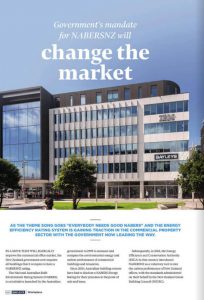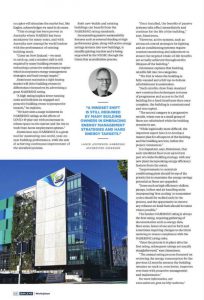There’s a very good article in the latest Bayley’s Auckland Office Workplace magazine talking about NABERZ – the initiative launched by the Aussie government to measure and compare the environmental energy and carbon performance of commercial buildings and tenancies.
It’s Australian law that building owners have to disclose their NABERZ energy rating for their building at the point of sale or lease, which we think is a fantastic initiative.
Around 4% of commercial buildings in NZ have a NABERZ rating but as of Jan 1, 2021, all government agencies in office accommodation are encouraged to follow these standards
It’s not compulsory for private sector yet but we think it’s something that should be seriously considered by all landlords. Having a star rating gives a vote of confidence to future lease-holders, especially in today’s world when the health of a workplace has never been more important. It signals lower running costs and a landlord that’s proactive and engaged. It’s an excellent tool for monitoring year on year building performance.
Our MD Lance Jimmieson was one of the first certified NABERZ accessors in NZ, that’s how much he believes it’s a great tool. He’s contributed his thoughts to this article, which you can read on page 64 HERE or below in full:
As the theme song goes “everybody needs good NABERS” and the energy efficiency rating system is gaining traction in the commercial property sector with the government now leading the way.
The National Australian Built Environment Rating System (NABERS), is an initiative launched by the Australian government in 1999 to measure and compare the environmental energy and carbon performance of commercial buildings and tenancies.
Since 2010, Australian building owners have had to disclose a NABERS Energy Rating for their premises at the point of sale and lease.
Subsequently, in 2013, the Energy Efficiency and Conservation Authority (EECA) in this country introduced NABERSNZ as a voluntary tool to rate the carbon performance of New Zealand offices, with the standards administered on their behalf by the New Zealand Green Building Council (NZGBC). It gives entire office buildings, or individual tenancies, an annual rating of zero to six stars on how well they use energy and these ratings are (or should be) updated annually.
A little over 418,000sqm of New Zealand office space currently has a NABERSNZ rating – representing just 4-percent of the estimated 10 million sqm of office space here.
There are three types of NABERSNZ energy ratings for office buildings:
· Tenancy: the energy performance of the floors and areas occupied mainly by the tenant, including computers, lighting, data centres, and staff kitchens
· Base building: this rating has the biggest impact on improving a building’s energy performance and measures the energy performance of a building’s core services – lifts, stairwell lighting, common toilets, air conditioning, and ventilation
· Whole building: measures both base building and tenancy ratings.
In a move that will shake-up the commercial office market, the New Zealand government will require all buildings that it occupies to have a NABERSNZ rating.
As of 1 January this year, the NABERSNZ standards are now compulsory for all agencies who occupy single-tenant, co-tenanted, or co-located government office accommodation with non-mandated agencies encouraged to follow these standards.
NABERSNZ ratings are still voluntary in the private sector but it is expected that the government example will be echoed by others in order to remain competitive in the market.
Andrew Eagles, chief executive of the New Zealand Green Building Council (NZGBC), says in requiring its many leased offices to now have a compulsory NABERSNZ rating, the Government can help lead the market towards a greater uptake of these standards – but it has been a long time coming.
“Government should have acted years ago,” he claims.
“The government is the largest and most significant occupier of buildings in Aotearoa, so having government departments seek NABERSNZ ratings on the buildings they lease does send a strong message to the rest of the sector.
“In Australia, where a NABERS rating is mandated, it has saved businesses AU$1billion in operating costs and also slashed 7-million tonnes of carbon emissions.
“Successive governments have done little to advance a mandate on this in New Zealand and while compulsory uptake of NABERSNZ for government-occupied buildings is good news, there’s still a way to go to match the achievements of Australia in this space.”
Eagles says the government’s commitment to the NABERSNZ standards in the buildings it occupies will be reflected tangibly in two key areas.
“It will lower the amount of money the government spends on energy bills and decrease the amount of operational carbon emitted by their buildings.”
“As tenants in the wider leasing market realise the benefits both in terms of operating costs and showing that their company is slashing carbon, they’ll want to be on the right side of history and demand a NABERSNZ rating, too,” says Eagles.
“However, our strong recommendation is for government to go further and mandate NABERSNZ for all medium and large office buildings as the benefits for businesses, and our zero carbon obligations, are all too obvious.”
Eagles points out that within New Zealand, there are various coalitions of businesses driving change in carbon reductions and they are growing in influence, and in numbers.
“More of these businesses are asking for NABERSNZ, and many more will in the coming years.
“New Zealand is now on a journey to being zero carbon by 2050, and that includes all our buildings – the built environment makes up 20 percent of our carbon footprint.
“If you want best-practice for your business, all you have to do is ask your landlord for a NABERSNZ rating.”
Taking that initiative will put your business on a journey to reducing operating costs, along with the climate impact of your office.
“Plus it’s a great story to tell your staff and stakeholders – and telling that story will also encourage others and drive further change, says Eagles.
“The economics, financing, politics, and people of New Zealand are all aligning behind a zero carbon Aotearoa, and that means having highly energy-efficient properties.”
Lance Jimmieson is a specialist building services engineer with 40 years’ industry experience and was one of the first in New Zealand to qualify as a NABERSNZ accredited assessor.
He says market interventions such as the government’s commitment to NABERSNZ ratings for the buildings it occupies will stimulate the market but, like Eagles, acknowledges we need to do more.
“This strategy has been proven in Australia where NABERS has been mandatory for many years, and with Australia now among the world leaders with the performance of existing building stock.
“Come on New Zealand – we need to catch up, and a mindset shift is still required by many building owners in embracing a proactive maintenance regime which incorporates energy management strategies and hard energy targets.
Jimmieson maintains a tight leasing market will drive building owners to differentiate themselves by advertising a great NABERSNZ rating.
“A high rating implies lower running costs and indicates an engaged and proactive building owner to prospective tenants,” he explains.
“We have seen a surge in interest in NABERSNZ ratings as the effects of COVID-19 play-out with an increase in release space on the market and the rise in work from home employment options.”
Jimmieson says NABERSNZ is a great tool for monitoring real-world, year-on-year, building performance, with the aim of achieving continuous improvement of the installed systems.
Both new-builds and existing buildings can benefit from the NABERSNZ rating standards.
Incorporating passive sustainability features such as external shading or high performance glass, along with active energy savings systems into new buildings, is steadily gaining traction and is being supported by the NZGBC through the Green Star accreditation process.
“Once installed, the benefits of passive systems take effect immediately and continue for the life of the building,” says Jimmieson.
“However, active systems, such as advanced control strategies for lighting and air conditioning systems require constant monitoring and adjustment to ensure the targeted whole-of-life benefits are actually achieved throughout the lifespan of the building.”
Jimmieson explains that building retrofits fall into two categories.
“The first is where the building is fully-vacated and a full top-to-bottom refurbishment is undertaken.
“Such retrofits draw from standard new construction techniques in terms of programme and access to the full building for a fixed timeframe then once complete, the building is commissioned and reoccupied.
“The second category is a progressive retrofit, where one or a small group of floors are refurbished while the building remains in use.
“While logistically more difficult, the important aspect here is to develop a master plan for all aspects of the building. and the building services, before the project commences.”
It is important, says Jimmieson, that each retrofitted floor is set-up to form part of a wider building strategy, with any new plant incorporating energy efficiency features from the outset.
“Improvements to central air conditioning plant should be top of the priority list to maximise the energy savings potential as floors are upgraded.
“Items such as high efficiency chillers, pumps, boilers and air handling units incorporating ‘free cooling’ or economiser cycles should be tackled early in the process, and the opportunity to remove any reliance on fossil fuels should be taken where possible.”
The hardest NABERSNZ rating is always the first rating, requiring gathering of documentation such as energy data, floor areas, hours of use and so forth and sometimes requiring changes to electrical metering to ensure compliance with the NABERSNZ rating rules.
“Once the process is in place after the first rating, subsequent ratings are usually straight-forward.
“The annual rating process focussed on reviewing the energy consumption for the previous 12 months ensures the building remains on track or, even better, improves over time with proactive management and maintenance.”
For more information, click here



